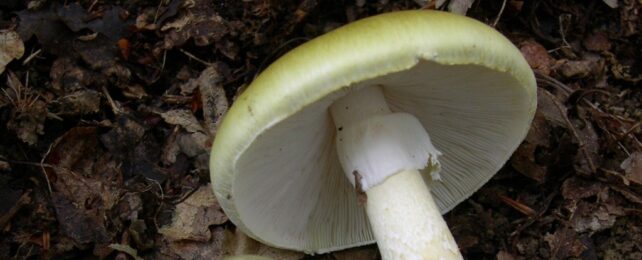Scientists just discovered valuable new insights about the most dangerous mushroom in the world. It's not reproducing like it used to, and that could be helping it move into new areas.
Mushrooms are infamous for mushroom poisoning, and yet in reality, most kinds of toxic mushrooms only cause temporary physical discomfort when eaten by humans.
Of all the reported fatalities from mushrooms worldwide, 90 percent are due to just one particular species from Europe: the 'death cap' mushroom (Amanita phalloides).
Researchers have now figured out how this species has spread across parts of North America with such speed and apparent ease, causing numerous fatalities along the way as people mistake it for food.
As it turns out, death caps don't need a mating partner to reproduce. A study led by researchers at the University of Wisconsin-Madison on A. phalloides in the US has found the mushroom can produce spores using the chromosomes of a single individual.
The discovery is based on the genomes of 86 mushrooms, collected in California since 1993 and parts of Europe since 1978.
Among the US samples, death caps appear to have been able to reproduce both sexually and asexually for at least 17 years, and possibly as long as 30 years.
Specimens collected in 2014 from two different spots were found to contain the exact same genetic material, effectively making them the same individual mushroom. Another 'individual' was collected once in 2004 and then again a decade later.
"The diverse reproductive strategies of invasive death caps are likely facilitating its rapid spread, revealing a profound similarity between plant, animal, and fungal invasions," the researchers write in their new paper.
Asexual spores are formed when a mushroom replicates its own set of chromosomes into two identical packages. Whereas sexual spores are formed when two different parents each gift a set of their chromosomes to their offspring.
Many species of mushroom-forming fungi are known to reproduce via both sexual and asexual spores, depending on the circumstances, but until this recent finding, no one knew that the death cap was one of them.
Sexual reproduction allows for species to evolve and adapt by introducing more genetic variation into a population. But by having an asexual mode, individual mushrooms can spread quickly and survive for years completely on their own.
When a mushroom's spore lands on a healthy surface, it germinates and begins fruiting. In this way, asexual spores can spread individual mushrooms far and wide, without the need for a mating partner or genetically different offspring.
The death cap mushroom originally comes from northern Europe, but over recent decades, it has been incredibly successful at invading new habitats in other parts of Europe, as well as North America and Australia. Asexual reproduction could be a big reason why.
Interestingly, researchers found the genes in the asexual spores collected in California from 1993 to 2015 were not all that different to the sexual spores produced by the same species in the same region.
According to theoretical models, this suggests individual death caps could persist through the years by replicating themselves until they find another death cap to mate with.
"Some of the offspring of these mushrooms mate, while others do not, and the cycle repeats," researchers hypothesize.
Unlike some other poisonous mushrooms, the appearance of the death cap is quite unassuming and can easily fool humans or pets looking for tasty snacks in a forest or park.
Half a mushroom cap is all that is needed to kill a person. Without medical intervention, symptoms can occur as soon as six hours after ingesting a fruiting body, with liver failure potentially following soon after.
Clearly, the spread of death caps is a serious risk to humans who may consume them. In 2016, during a particularly bad local outbreak of death caps in San Francisco, 14 poisoning cases in humans were attributed to the mushroom. Usually in the US, there are just a few a year.
Now that scientists have a better idea of how death caps are spreading in North America, maybe they can start putting together strategies to contain the risk.
In the meantime, anyone interested in foraging for mushrooms should look up whether death caps are present in their area and make sure they know exactly what they are throwing into the frying pan.
The study was published in bioRxiv.
